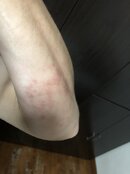I went diving last Friday, I didn’t inflate my bcd well and I sank to the bottom of the seabed. To “break” my fall, I used my forearm to shield against a rock that’s on the seabed. Upon contact with the rock, I felt a slight stinging sensation and slight burning feeling. I didn’t pay much attention to it and continued to dive. It was until I reached home that I realised that there were tiny bumps and rashes on the area that was in contact with the rock on the seabed. It wasn’t painful or burning but just itchy. It’s been almost a week plus and it’s still there. Is there any thing I could do to help with the healing?
Is it a hydroid sting? Or something else? How Long does it usually take to heal completely?
Thanks In advance.
Is it a hydroid sting? Or something else? How Long does it usually take to heal completely?
Thanks In advance.




